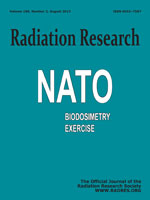The role of mast cell infiltrates in the pathology of radiation damage to the lung has been a subject of continuing investigation over the past four decades. This has been accompanied by a number of proposals as to how mast cells and the secretory products thereof participate in the generation of acute inflammation (pneumonitis) and the chronic process of collagen deposition (fibrosis). An additional pathophysiology examines the possible connection between mast cell hyperplasia and pulmonary hypertension through the release of vasoactive mediators. The timing and magnitude of pneumonitis and fibrosis are known to vary tremendously among different genetic mouse strains and animal species. Therefore, we have systematically compared mast cell numbers in lung sections from nine mouse strains, two rat strains and nonhuman primates (NHP) after whole thorax irradiation (WTI) at doses ranging from 10–15 Gy and at the time of entering respiratory distress. Mice of the BALB/c strain had a dramatic increase in interstitial mast cell numbers, similar to WAG/Rij and August rats, while relatively low levels of mast cell infiltrate were observed in other mouse strains (CBA, C3H, B6, C57L, WHT and TO mice). Enumeration of mast cell number in five NHPs (rhesus macaque), exhibiting severe pneumonitis at 17 weeks after 10 Gy WTI, also indicated a low response shared by the majority of mouse strains. There appeared to be no relationship between the mast cell response and the strain-dependent susceptibility towards pneumonitis or fibrosis. Further investigations are required to explore the possible participation of mast cells in mediating specific vascular responses and whether a genetically diverse mast cell response occurs in humans.
How to translate text using browser tools
2 July 2013
Do Variations in Mast Cell Hyperplasia Account for Differences in Radiation-Induced Lung Injury among Different Mouse Strains, Rats and Nonhuman Primates?
Julian D. Down,
Meetha Medhora,
Isabel L. Jackson,
J. Mark Cline,
Zeljko Vujaskovic
ACCESS THE FULL ARTICLE
<
Previous Article
|

Radiation Research
Vol. 180 • No. 2
August 2013
Vol. 180 • No. 2
August 2013




